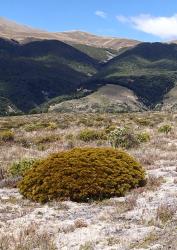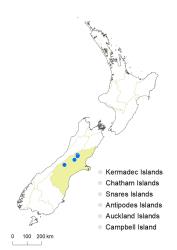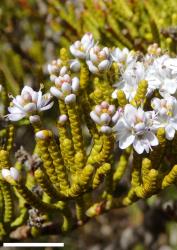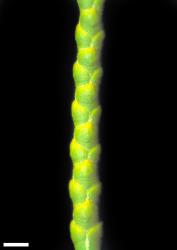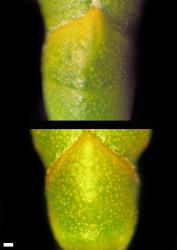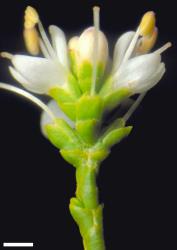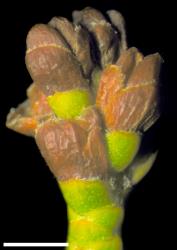- ≡ Hebe armstrongii (Johnson ex J.B.Armstr.) Cockayne & Allan, Trans. New Zealand Inst. 57: 40 (1926)
- ≡ Leonohebe armstrongii (Johnson ex J.B.Armstr.) Heads, Bot. Soc. Otago Newsl. 5: 7 (1987)
Bushy whipcord shrub to 1 m tall. Stems ascending to erect, glabrous except for narrow line of eglandular hairs at the connate leaf bases, and sometimes hairs bifarious to uniform at base of internodes. Leaf bud indistinct, its outer leaves fully grown, diverging. Leaves opposite-decussate, connate in pairs and encircling stem, appressed but not usually covering the more or less distinct node above, scale-like; lamina coriaceous, broadly deltoid, 1.0–1.5 mm long, 2–3 mm wide, more or less glossy yellowish-green above and beneath; veins not evident, although sometimes leaf longitudinally wrinkled when dry; surfaces glabrous; margins conspicuously shortly ciliate to ciliolate, entire; apex obtuse, apiculate or sub-apiculate; base broad; petiole absent. Inflorescence a terminal spike, 2.5–8.5 mm long; flowers crowded, 2–10, all bisexual; bracts opposite-decussate and connate, broadly deltoid; pedicels absent. Calyx lobes 4, seemingly 3 because anterior pair fused to apex and sometimes shortly split there, occasionally posterior pair partly fused as well, obtuse, 1.3–1.8 mm long, unequal, densely shortly eglandular-ciliate to -ciliolate mixed with short glandular hairs as well. Corolla 4.5–7.0 mm diameter; tube white, 1.0–1.7 mm long, ≤ calyx, hairy inside; lobes 4, white, sometimes tinged mauve, sub-erect to spreading, unequal, elliptic to obovate, 2.0–3.5 mm long, obtuse to rounded; nectar guides absent. Stamen filaments white, 2–3 mm long; anthers magenta or pink to yellowish. Style glabrous, 2–4 mm long. Capsules latiseptate, rounded, glabrous, 2–3 mm long, 1.4–2.2 mm at widest point. Seeds ellipsoid-oblong to discoid, weakly flattened, smooth, straw-yellow to pale brown, 0.9–1.3 mm long.
In dried (herbarium) specimens the leaves spread away from the stems and each connate pair forms an almost obconic skirt around the leafy branch. Veronica armstrongii plants are most similar to V. annulata, which can be distinguished by their slightly larger leaves that remain more or less appressed when dried, and their leaf apex obtuse without an apiculus. Two other whipcord hebes have fused anterior calyx lobes: V. salicornioides plants have longer internodes and tightly appressed leaves, which gives a smooth surface to the leafy stem; V. ochracea plants have thicker, leafy stems, ovate to deltoid leaves, more yellowish to bronze coloration, as well as a higher chromosome number and distribution in the northern South Island.
V. armstrongii is sometimes mistaken for Halocarpus bidwillii (bog pine), which it resembles when not in flower. However, whipcord hebes have strictly opposite-decussate leaves, whereas those of podocarps like Halocarpus are spiralled.
South Island: Canterbury (Waimakariri and Rangitata Valleys).
River terraces and bogs, often with Halocarpus bidwillii. Recorded elevations range from 700 to 1220 m.
A plant of V. armstrongii × odora from Pūkio Stream, Esk Valley, has been brought into cultivation as Veronica ‘Karo Golden Esk’.
Flowers: October–January; fruits: December–May, persisting all year.
2n = 84 (see Bayly & Kellow 2006, as Hebe armstrongii).
Veronica armstrongii is classified in V. subg. Pseudoveronica sect. Hebe and informally in the “Flagriformes” group, also known as “whipcord hebes” (Albach & Meudt 2010; Bayly & Kellow 2006). It is most likely related to V. annulata, V. salicornioides, and V. ochracea, similar whipcord hebes that have 2n = 42, 124, and the anterior calyx lobes fused together.



